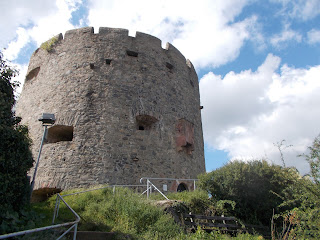 |
| Lichtenberg Palace Viewed From the Bastion |
Rising high above the charming landscape of Fischbachtal (Fish Creek Valley) on the northern edge of the Odenwald, stands Lichtenberg Palace. Built in the 1500s, the current renaissance palace is the successor to an earlier Medieval castle built in the 13th century. The palace and the surrounding grounds are a very popular with visitors, especially in the summer and during the advent season when the community hosts various events and festivals.
History
There is little known about the original castle from the middle ages that existed where the current Renaissance palace now lies. Of the previous structure from the 1200s, only a few parts o
f the walls and the foundations remains. The fact that Count Diether III von Katzenelnbogen married a woman named Bertha von Lichtenberg sometime between 1190 and 1214 tells us that an even earlier castle existed on the site prior to their marriage. The first documented evidence of the castle’s existence, however, comes from a court document in 1288 from the regional court in Heppenheim in which Count Diether IV von Katzenelnbogen called himself “comes (count) de Lichtenberg.”
 |
| The Bastion Built in 1503 |
In 1312, the Holy Roman Emperor, Henry II, in gratitude for services rendered by Count Diether VI to the empire in Italy, granted the castle and the village of Gross Bieberau rights equal to those of the town Oppenheim. This meant that Lichtenberg and Gross Bieberau were “free” and answered only to imperial authority. Gross Bieberau was also granted the right to hold a weekly market on Tuesdays, and the emperor also granted permission that twelve Jews could reside in the Lichtenberg-Bieberau area.
 |
| A View of the Stables, Smithy and Barn |
After Count Diether VI was killed in a tournament, his wife, Katharina von Kleve, lived in the castle under a right of widow's easement until her death. At that time, the castle was inherited by her daughter Elisabeth, who had married Count Philip von Sponheim. The couple’s marriage in 1320 put the castle in the hands of the von Sponheim’s, and it wasn’t until the death of Heinrich von Sponheim in 1393 that it was returned to the Katzenelnbogen family.
With the death of Count Philip I in 1479, the
Katzenelnbogen line died out, and Lichtenberg Castle became the property of the Landgraves of Hessen. In 1570, Landgrave Georg I von Hessen-Darmstadt began the construction of the renaissance palace you see on the site today, the first of its kind in south Hessen. The new palace became a model for others in the area, including the palace in Darmstadt. Lichtenberg palace was a favourite of the Hessen-Darmstadt family, and it served as a base for hunting parties and a place of retirement for widows in the family. In the Thirty Years’ War, the Landgrave family moved their seat of residence to Lichtenberg to avoid invading armies and the plague. The castle remained largely unscathed during the war despite the fact that the surrounding area suffered a great deal.
 |
| Door to Palace, Showing Coat of Arms of Landgrave Georg I and his Wife |
 |
| The Gate House |
Today, the palace is owned by the state of Hessen, though a portion of it has been rented out as a private residence since the 1950s. There is a small museum located in the east wing, which can be viewed upon advanced request and a permanent exhibition of works by the painter Johannes Lippman is on display in the emperor’s hall (Kaisersaal). The hall is also used as a venue for concerts due its superior acoustics and is also available for rent for private functions.
Address:
|
Landgraf Georgstraße 64405 Fischbachtal
+49 6166 93000
|
Opening Times and Fees:
|
See the castle website for information about museum opening times, tours, events and associated fees
|
“Schloss Lichtenberg Über Dem Fischbachtal.” Schloss Lichtenberg, 2008, www.burgenwelt.org/deutschland/lichtenberg5/index.htm
webcontact.de. Schloss Lichtenberg, www.fischbachtal.de/schloss/.
No comments:
Post a Comment